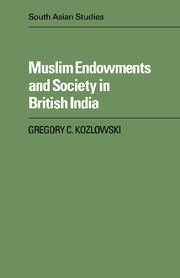Book contents
- Frontmatter
- Contents
- Acknowledgments
- Note on transliteration
- Abbreviations
- Introduction
- 1 Endowments in Muslim history, an overview
- 2 Muslim endowments and the temporal order in British India
- 3 Endowments and the faith
- 4 The unsettling of endowments
- 5 Creating a law of Muslim endowments
- 6 Muslim endowments and the politics of religious law
- Conclusion
- Bibliography
- Index
- CAMBRIDGE SOUTH ASIAN STUDIES
1 - Endowments in Muslim history, an overview
Published online by Cambridge University Press: 25 October 2011
- Frontmatter
- Contents
- Acknowledgments
- Note on transliteration
- Abbreviations
- Introduction
- 1 Endowments in Muslim history, an overview
- 2 Muslim endowments and the temporal order in British India
- 3 Endowments and the faith
- 4 The unsettling of endowments
- 5 Creating a law of Muslim endowments
- 6 Muslim endowments and the politics of religious law
- Conclusion
- Bibliography
- Index
- CAMBRIDGE SOUTH ASIAN STUDIES
Summary
one day a drunken mullah
gave his verdict on the Holy Law.
“Drinking wine is bad”, he said,
“but having a waqf is worse.” Hafiz
Endowments outside India
The Holy Quran made no mention of awqaf or any institution similar to them. When later generations of Muslims sought a sanction for endowments, they turned to the collections of anecdotes (ahadīs) which reported the sayings and doings of the Prophet. An incident related by several sources provided the canonical origin of the institution. Umar, the man who became the second caliph, received groves and fields as booty after the conquest of the oasis at Khaibar. Umar wondered about the best use for that property and asked the Prophet's opinion. The Messenger of God told Umar to “tie up” (one of the basic meanings of the verb waqafa) the land and gardens and devote any income to the welfare of the faithful.
Endowments, as this narrative showed, had a role in helping Umar deal with a new situation. He, the Prophet, and many of the first Muslims were town-dwelling merchants. Trade goods and cash were the forms of wealth which they knew best. When the community's early triumphs brought moveable wealth as booty, the faithful shared out the newly acquired goods, apparently without difficulty. The same procedure took place with the lands of Khaibar. However, as Umar's concern to do the right thing with his portion demonstrated, believers were somewhat uncertain about how to deal with immoveable property once they received it.
- Type
- Chapter
- Information
- Muslim Endowments and Society in British India , pp. 10 - 40Publisher: Cambridge University PressPrint publication year: 1985

